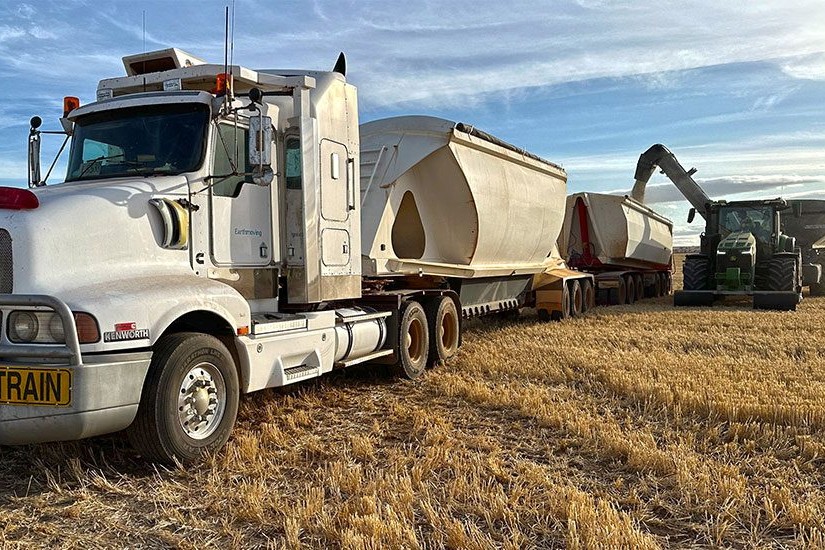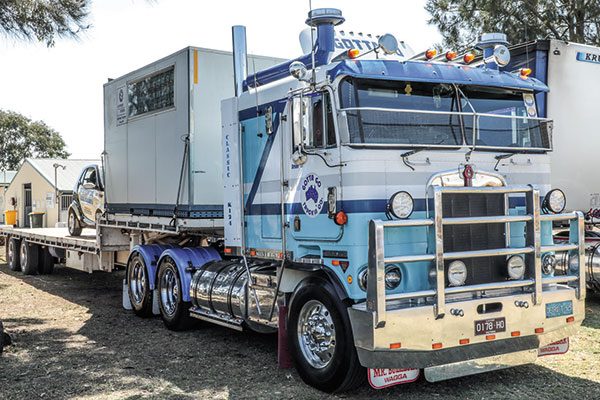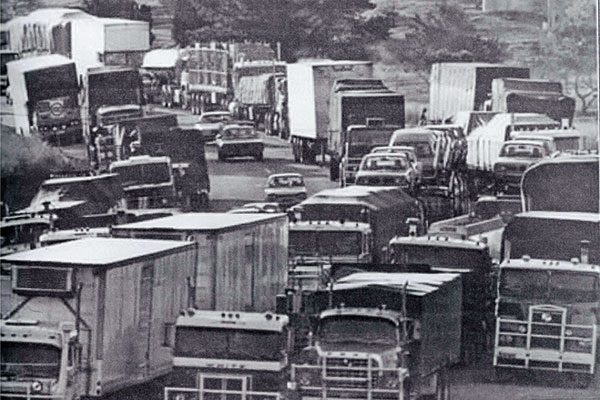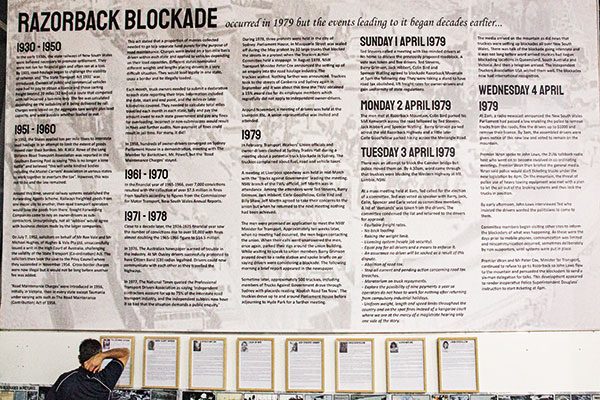The engineers call it ‘intensive linehaul application‘: the operators call it their job. Nevertheless, it‘s one hell of a job: one truck, and a handful of dedicated drivers on a run that traverses the entire state of Queensland with time sensitive produce in high tech sophisticated modern machines.

It was little after smoko one Wednesday when my phone rang. It was Utchee Refrigerated Transport owner Graham Hampson. “What are you doing on Friday?” he casually asked. “Probably checking out one of your new K200s,” I cheekily replied. And, sure enough, that‘s what he‘d had in mind.
This K200 does a regular run from Far North Queensland, 1600-odd kilometres to the markets in Brisbane, with North Queensland-grown produce. Then it returns to Far North Queensland with much-needed supplies before reloading fresh produce again. It is a gruelling task on both men and machines. Banana growers, like Graham, are often at the mercy of diverse scenarios from cyclones through to impassable flooded roads that all chip away at their bottom line and sometimes wash away a season‘s income. It was during the Queensland floods of 2010 that Graham had five B-double-loads with 2200 cartons of produce stranded in each truck, all incapable of reaching southern markets. Graham was furious, he knew his freight could get through if only the trucks took the drier inland route, but the transport company he was using refused to run the inland route, even after the offer of additional money to go around the floods. Ironically the price per carton at the Sydney markets rose significantly as the supply of produce from North Queensland slowed due to the floods. “We missed a rare business opportunity,” Graham lamented.
“It‘s much the same in cyclone season. When growers can‘t get their produce to market on time, they have to go another nine to 10 months without any income coming in.” It wasn‘t long after that episode that Graham purchased two K200 prime movers and B-double trailer sets and took total control of the family farm‘s transport operation, sort of a ‘paddock to the plate‘ service. Since their inception in 2010 their fleet size has grown considerably, to half a dozen B-double and a couple of road trains, as demand for their home-grown service has increased.

Photo: Not quite ripe just yet, but they will be by the time they get there.
Produce like bananas are temperature sensitive commodities; there is a certain skill to get them from the tree to the market, requiring meticulous handling and where an error in timing can mean the difference between losing a crop or not. Consequently, reliability of the equipment is paramount in such a time-sensitive operation where produce is harvested just before it matures and finishes ripening on the journey to the market. Kenworth trucks and Barker trailers with BPW axles are Graham‘s preferred spec.
‘If you‘ve got the best gear you can deliver the best service,” Graham added. “Sure, the best gear might cost a little more up front, but you don‘t have the maintenance issues or downtime.” The Utchee Refrigerated Transport K200s are typical fleet spec with 410kW (550hp), (peak power is 433kW (580hp)) and 2500Nm (1850ft/lb) torque, coupled to an 18-speed UltraShift PLUS transmission through to Dana D46-170 rear axles running a 4.10:1 ratio riding on Kenworth Airglide 460. But that‘s where the similarities with a typical fleet spec ends; these K200s boast a full complement of high tech safety features that include discs brakes on the front and rear axles on the prime mover as well as the Barker trailer B-double set, all matched up with electronic stability control (ESC) and electronic braking system (EBS).
Improving safety for his drivers was the driving force behind speccing the latest disc brake technology on the fleet of K200s. Research indicates modern truck stopping distances have reduced almost 30 metres compared with trucks built before 2010, however over the past decade the tightening of regulations around the world regarding heavy vehicle braking is forcing brake manufacturers to improve braking performance, longevity and serviceability. Graham is the first to admit that when it comes to which style of brakes – discs or drums – was right for his trucking operation, the disc brakes certainly won the head-to-head challenge in stopping distance, but didn‘t necessarily tick all the Surprisingly, there is little difference in the weight of drum or disc, and on the long-haul interstate runs that Utchee Refrigerated Transport‘s K200 and Barker trailers run, there was negligible gain in terms of weight with either technology.
However, when it comes to maintenance the discs offer considerable uptime benefits. Firstly, there is no required periodic lubrication schedule the way there is for a drum brake. To make matters even easier, most disc brakes have a visual wear indicator; this gives the maintenance personnel or even the driver a simple, quick, easy-to-see method to check remaining pad lining amount without removing the wheel to measure the pad. Not only does this save a significant amount of maintenance time in the workshop, it also negates the cost of purchasing additional lubricants for the brake system.
Secondly, most workshop service managers agree that when it comes time to replace the disc pads, there‘s an approximate 50 percent time saving compared with a drum brake reline. For Graham, the choice to go with the disc brake option was not only safety driven but also came with significant economic gains. Even though the initial purchase price of the disc brake option is roughly $6K more than standard drum brakes, it is the reduction in total cost of ownership over the life of the vehicle that really makes the disc brake option viable. Pre-trip inspections can be performed easily on the new K200 via a bright finish stainless steel access door covering the filler tube and dipstick. Yet it was how the K200 performed on the road in the heat of Far North Queensland that we‘d come to experience. This particular K200 was powered by the Cummins X15 coupled to an Eaton 18-speed transmission. The Dana final drive on this K200 is somewhat taller than you‘d expect to find on a B-double unit at 4.10 ratio, however this is what Cummins are suggesting; gear fast and run slow, with even taller ratios for some applications to enhance fuel economy.

Photo: The drivetrain is fleet spec to a point, but then there‘s added safety and productivity tweaks to give them an edge.
It quickly became apparent that the new spec Cummins X15 certainly didn‘t lack any punch and was more than willing to respond to each command of the throttle even from as low down as 1200rpm. The turbo-boost pressure gauge wound itself around to end as the throttle went down. From a seat of the pants point of view it is interesting to note that even though there is plenty of power getting to the ground, it can be somewhat deceptive when you‘re behind the wheel, because it is so quiet with the engine running at low revs. Interior cabin appointments are first class and the instrument layout features the warning light cluster with easy to read Prestige gauges. Vision from the driver‘s position is also fantastic in the K200 cabin.
The upshot of the improved cylinder air volume from the high-speed turbo is that the engine braking capability is 15 percent higher through the engine brake rev range. In practice, the engine brake certainly does have the goods where it counts as it more than adequately held the fully loaded B-double on the descent down the Cardwell Range.
Graham admits the evolution in road transport is something he never would have envisaged when he first started sending his produce to market a few decades ago. “These new K200s will probably have a million kilometres on them in four years,” Graham said. “Compare that with the trucks that used to pick up our bananas back in the eighties and they never even came close to covering that sort of distance in that time. Back then you‘d typically rebuild an engine at half a million kilometres and now we expect to get at least a million out of them before we put a spanner on them.
 |
 |
“There is no question we get a good run out of the Kenworth, Cummins and Barker product,” Graham added. “Mind you, over the years we‘ve had our occasional moments with them too, but in the end, we‘ve been loyal to them and we do receive good service from Brown and Hurley and Cummins, which is ultimately what keeps us all going and why we specify Kenworth and Cummins products.”
Read more
In search of old KS
0 Comments5 Minutes
When things changed forever
0 Comments11 Minutes





